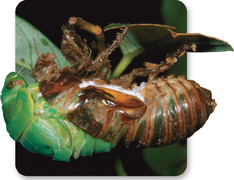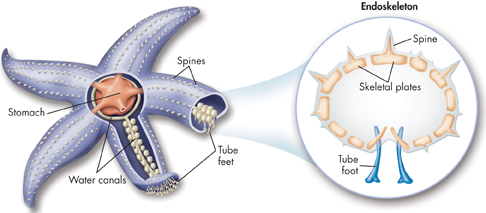▸ Exoskeletons Many arthropods have exoskeletons, as do most mollusks, such as snails and clams. The exoskeleton, or external skeleton, of an arthropod is a hard body covering made of a complex carbohydrate called chitin. Most mollusks have exoskeletons, or shells, made of calcium carbonate.

FIGURE 28–9 Exoskeleton Arthropods such as this cicada periodically “grow out” of their exoskeletons and have to break out of them in order to grow new ones. Infer How might molting be a dangerous inconvenience?
Jointed exoskeletons enable various arthropods to swim, fly, burrow, walk, crawl, and leap. They can also provide watertight coverings that enable some arthropods to live in Earth's driest places. An exoskeleton can also provide physical protection from predators—as you know if you have ever tried to crack a crab or lobster shell or seen a mollusk withdraw into its shell. Mollusks with two-part shells are called bivalves. Bivalves such as clams can also close their shells to avoid drying out.
But exoskeletons have disadvantages. An external skeleton poses a problem when the animal it belongs to needs to grow. To increase in size, arthropods break out of their exoskeleton and grow a new one, in a process called molting, shown in Figure 28–9. Exoskeletons are also relatively heavy. The larger arthropods get, the heavier their skeletons become in proportion to their body weight. This is one reason that some science-fiction monsters could never exist. The legs of an elephant-size spider would collapse under the spider's weight!
▸ Endoskeletons Echinoderms and vertebrates have endoskeletons. An endoskeleton is a structural support system within the body. Sea stars and other echinoderms have an endoskeleton made of calcified plates, as you can see in Figure 28–10. These skeletal plates support and protect echinoderms, and also give them a bumpy texture.
Vertebrates have an endoskeleton made of cartilage or a combination of cartilage and bone. Sharks and some other fishes have skeletons made almost entirely of cartilage. In other vertebrates, most of the skeleton is bone. Four-limbed vertebrates also have structures called limb girdles that support limbs and allow the animal to move around.

FIGURE 28–10 Endoskeleton Not every endoskeleton looks like yours! Some invertebrates, including echinoderms such as this sea star, have rigid internal body supports. These supports are not, however, made of bone.

Table of Contents
- Formulas and Equations
- Applying Formulas and Equations
- Mean, Median, and Mode
- Estimation
- Using Measurements in Calculations
- Effects of Measurement Errors
- Accuracy
- Precision
- Comparing Accuracy and Precision
- Significant Figures
- Calculating With Significant Figures
- Scientific Notation
- Calculating With Scientific Notation
- Dimensional Analysis
- Applying Dimensional Analysis




